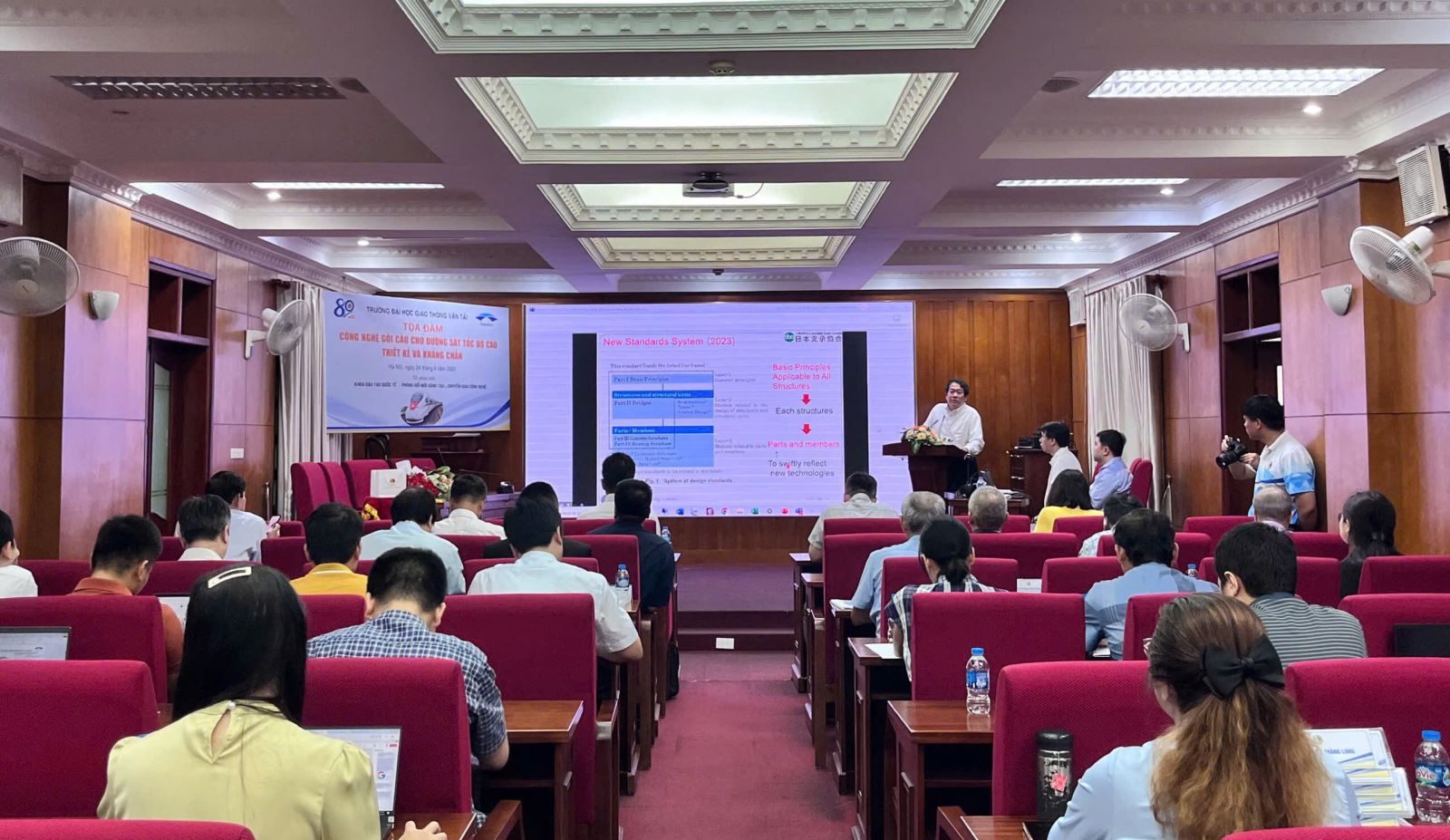Seminar “Bearing Technology for High-Speed Rail - Design and Seismic Resistance”
On June 24, 2025, the University of Transport and Communications organized an international scientific seminar themed “Bearing Technology for High-Speed Rail – Design and Seismic Resistance.” The program attracted the participation of more than 100 delegates, including experts, managers, lecturers, engineers, and enterprises from Vietnam and Japan.
.jpg)
Delegates attending the seminar take a group photo.
The seminar was jointly organized by the Faculty of International Education and the Department of Innovation & Technology Transfer – UTC, aiming to share advanced technical achievements in the field of seismic isolation bearing design – a key component in the structural system of high-speed railway bridges, especially in the context of Vietnam preparing to implement the North–South high-speed railway project.

The seminar attracted a large number of businesses, managers, and scientists participating both in person and online
Key factor ensuring operational safety for the structure
Speaking at the seminar, Assoc. Prof. Dr. Nguyen Thi Tuyet Trinh – Dean of the Faculty of International Education, University of Transport and Communications – stated that the upcoming North–South high-speed railway project is a strategic infrastructure work of national significance. It not only contributes to promoting regional connectivity and sustainable development but also symbolizes a technological transformation in the country’s transport sector.
Due to the characteristic of the track running predominantly on bridges, the technical requirements for the span structures—and especially the bearings, which serve as the intermediate components transferring loads between the spans and piers—become extremely important. Bearings not only bear static and dynamic loads under normal operating conditions but also serve as a key factor ensuring the operational safety of the structure in extreme situations such as earthquakes and natural disasters.
.jpg)
Assoc. Prof. Dr. Nguyen Thi Tuyet Trinh – Dean of the Faculty of International Education
According to Prof. Dr. Tran Duc Nhiem from the Faculty of Civil Engineering at the University of Transport and Communications, for railway systems designed to operate at speeds between 250 km/h and 350 km/h, bearings must meet very high requirements for stiffness, fatigue resistance, and long-term smoothness for trains. In high-speed rail systems, bearings play a crucial role as intermediate components between the superstructure and substructure, functioning to transfer loads from the spans to the abutments and piers. They also allow for displacement and reduce stresses caused by thermal expansion, train loads, and foundation deformations, thereby ensuring smoothness, safety, and operational efficiency of the high-speed railway system.
.jpg)
Prof. Dr. Tran Duc Nhiem – Faculty of Civil Engineering, University of Transport and Communications
Experience from Japan
Dr. Takehiko Himeno – Head of the Engineering Department of the Japan Bearing Association – shared that Japan’s high-speed rail system currently has an operational length of approximately 3,300 km, stretching from north to south, and is continuing to expand with the Hokkaido Shinkansen line. Alongside infrastructure development, Japan has maintained a railway bridge standard system with a history of over seven decades, beginning in 1914. A major milestone occurred in 1964 with the opening of the Tokaido Shinkansen, which established the “design perspectives” framework for high-speed rail structures still in use today.
Regarding the quality management regulations for bearings, Dr. Takehiko Himeno stated that, in addition to conducting comprehensive vertical and horizontal tests, fatigue verification tests under 2 million repeated compressive loads and fatigue assessment during 2 million cycles of rotational loading must also be performed. These tests ensure the bearing’s operational capability and check the material’s magnetic properties. This is crucial for the safe operation of the entire bridge structure when high-speed trains run continuously.
.jpg)
Sharing Experience on Bearing Technology for High-Speed Rail from Japanese Experts
Need to Improve Standards
To meet the requirements for bearings in high-speed rail systems suitable for Vietnam’s conditions, many experts have proposed improvements, including the addition of specific guidelines on selecting the appropriate type of bearing for each common bridge structure in Vietnam. This will help designers make more suitable decisions aligned with the structural functions.
At the seminar, many experts analyzed and compared with international standards, emphasizing the need for further additions when applying TCVN 13594-8:2023 in practice. They recommended clearer guidance on selecting the appropriate bearing type for typical structural layouts; detailed requirements for physical testing, long-term performance evaluation, periodic inspection, and behavior under repeated loads, fatigue, and seismic conditions.
.jpg)
Mr. Phung Tien Vinh – Deputy Director General of the Department of Economics – Construction Investment Management, Ministry of Construction – shared at the seminar
ICDS
